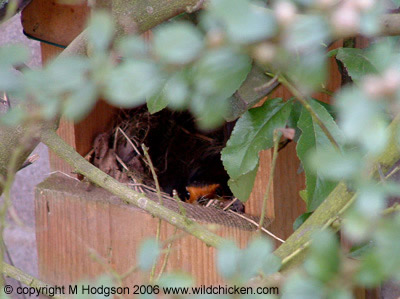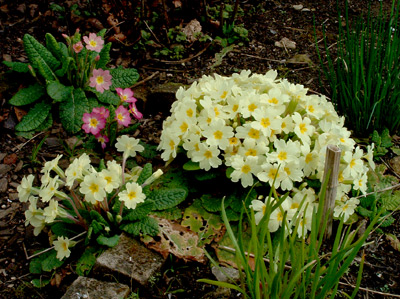7th April 2006 - Spring is springing
Blackbird update – she’s still sitting on the eggs, but none have hatched yet.
"Neither of us had noticed robins taking nesting material in, or collecting it, so they must have been pretty discreet."
Meanwhile, on the other side of the garden, the robin box that we put up behind a Ceanothus thyrsiflorus var. repens is finally being used. Initially, we thought it was only being used for roosting on cold nights, but on a closer look we saw a neat cup-shaped nest tucked into the open fronted box, the lip of the nest below the entrance, out of the wind. Neither of us had noticed robins taking nesting material in, or collecting it, so they must have been pretty discreet.
Other birds – starlings, for example – are very obvious and you see them flying off with beakfuls of material nearly as big as themselves. Last year I watched a starling nip off every bit of new growth from a Lavender I’d just planted out and carry it away (the plant recovered quite quickly, by the way). The blackbird, when she was collecting, scratched up a large amount of moss from under the garden bench, leaving a bare patch, while the sparrows have been known to all but destroy clumps of Stipa tenuissima. But we hadn’t seen the robin pick up anything at all, not one strand or rootlet.
Luckily for us, the robin’s nest is visible from the bedroom, like the blackbird’s, so we can spy on both of them now, without even needing to move. The first thing I do each morning after opening the curtains is to pick up the binoculars from the windowsill and see if anything has changed.
On Monday, horror struck. It's been very wet and windy here for the last week or so, about as it should be for this time of year, of course. After a night of howling winds, which sometimes made me wonder if the roof would stay on, I looked down to see the robin box face down on the soil. I woke Karl and we both went out to check (isn’t it lovely that on a cold morning he’ll leap out of a warm and cosy bed for distressed robins?).
The box had come down because the wood had split at the back, where it was drilled to fit over the screw it hooked onto. We lifted it carefully, fearing we’d find an injured robin trapped inside. Thankfully there was no bird, but five creamy-brown little eggs had spilled out onto the ground, one broken. We both remembered being told as children that you shouldn’t touch birds’ eggs, because the scent from your fingers might put the birds off and they’d abandon the nest. But we couldn’t just leave it like that. What to do?
The best thing we could think of was to phone our friend, John Davison, down the road. He’s been watching birds for nearly 70 years and is extremely knowledgeable; he’d know what to do. His suggestion was to put the box back up and replace the eggs, putting everything as closely as possible the way it was before. Robins, he said, are very territorial and if the hen sees her nest and eggs reinstated, she’ll very likely go back and sit on them again. ‘Let’s just see how strong her maternal instinct is’ he said.
So we put the box back up, more securely than previously, carefully replaced the eggs, then went straight back upstairs to look out of the window. Only a few minutes had gone by when a robin flitted across the road from the woods over the road and landed on a nearby shrub. Moments later, it was joined by another. They sat for a while, seeming to look at the nest box, and then took off into the woods again. I phoned John with the update. ‘They’ve probably gone off to think about it’ he said. We waited a while longer but they didn’t come back, so we left them to their conferring and came into the office, feeling rather distracted, to start work.
Some two hours later, passing the bedroom door, I couldn’t resist a quick glance out of the window. And there, just visible over the edge of the nest, was the top of a little red and brown head, with two beady black eyes gazing steadily out at the world. The robin. Despite all the upheaval, being tossed out of bed in the night, eggs scattered, then having her hideaway manhandled by us, she’d returned. Several days later, she’s still sitting tight, only leaving the nest a couple of times a day to feed, drink and bathe. Time will tell, but we hope that in a couple of weeks or so we’ll be watching baby robins.

The robin, taken from several feet, with a zoom lens. This is more or less what we see through the binoculars.
Elsewhere, spring is still trying to get going and there have been some fine days. Even so, it’s tried to snow a few times. The Eschscholzia seeds sprinkled in the ‘new’ area last week are starting to germinate and there are a few green tufts showing. The transplanted grasses are showing no growth yet, but the Echinops ritro seem happier in this spot and have started sprouting, as have the Sedum and Geranium phaeum.
The deep pink Paeony that was here when we moved in is pushing up red stems topped with tightly folded leaves, like tiny red cabbages, and there are the pinky-red stems of Dicentra spectabilis forming.
The most colourful plant of the moment are the bird-sown primroses (Primula vulgaris). They’ve been blooming for most of the winter but have suddenly burst into fat posies of flowers. Most are pale yellow but this year some are coming up pink. Every so often you see one of the first bumblebees of the year weaving across the garden, eventually finding their way to this useful early source of food.

Bird-sown primroses
Finally, after saying last time that there was no sign of frogs or their spawn yet, we looked out on March 25th to see three big clumps of it, smack in the middle of a potted aquatic plant. Another two clumps have been laid since then - two more than in 2005. Last year’s first sighting was the 17th of March, so they’re not that far behind.
A good deal further behind is the first lawn cut of the year. It hasn’t been done yet and last year’s first cut was the 10th of March. Part of the reason for this has been the weather but the main is that we still haven’t got a new lawn mower. Saying that, the hum of the weekend lawn mower hasn’t yet joined the other sounds of spring so we aren’t tardy.
© Copyright Miranda Hodgson 2006